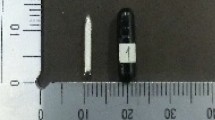Abstract
The purpose of this study is to determine the residual radioactivity of the patient-specific brass aperture induced by the proton beam of a single-ring wobbling system and the consequent radiation exposure to patients and staff. The gamma-ray spectra of the activated brass block were obtained using a high-purity germanium detector, following which the radionuclides were analyzed. Residual activity within the brass block was measured through the efficiency transfer method, and volume-source models were developed according to the distribution of the residual activity. The fitting equations for efficiency transfer factors were established with consideration of the activity distribution along the proton-beam direction. The ambient dose rate contributed by the activated brass was reduced to the level of the background radiation within approximately 3 h. Nevertheless, the residual activity of induced radionuclides with long half-lives, such as cobalt, which dominate the residual activity, should be monitored to ensure radiation safety.








Similar content being viewed by others
References
Kase Y, Yamashita H, Numano M, Sakama M, Mizota M, Maeda Y, et al. A model-based analysis of a simplified beam-specific dose output in proton therapy with a single-ring wobbling system. Phys Med Biol. 2015;60:359–74. https://doi.org/10.1088/0031-9155/60/1/359.
Akagi T, Higashi A, Tsugami H, Sakamoto H, Masuda Y, Hishikawa Y. Ridge filter design for proton therapy at Hyogo ion beam medical center. Phys Med Biol. 2003;48:N301–12. https://doi.org/10.1088/0031-9155/48/22/N01.
Chen H, Matysiak W, Flampouri S, Slopsema R, Li Z. Dosimetric evaluation of hybrid brass/stainless-steel apertures for proton therapy. Phys Med Biol. 2014;59:5043–60. https://doi.org/10.1088/0031-9155/59/17/5043.
Yonekura Y, Tsujii H, Hopewell JW, Lopez PO, Cosset J-M, Paganetti H, et al. Radiological protection in ion beam radiotherapy (no. ICRP publication 127). Annals ICRP. 2015. https://doi.org/10.1177/0146645314559144 43, 5, 113.
Mukherjee B. Radiation safety issues relevant to proton therapy and radioisotope production medical cyclotrons. Radiat Prot Environ. 2012;35:126. https://doi.org/10.4103/0972-0464.117668.
Walker PK, Edwards AC, Das IJ, Johnstone PAS. Radiation safety considerations in proton aperture disposal. Health Phys. 2014;106:523–7. https://doi.org/10.1097/HP.0b013e3182a2a725.
Sharshar T, Elnimr T, El-Husseiny FA, El-Abd A. Efficiency calibration of HPGe detectors for volume-source geometries. Appl Radiat Isot. 1997;48:695–7. https://doi.org/10.1016/S0969-8043(97)00004-3.
Medhat ME, Wang Y. Assessment of the suitability of Monte Carlo simulation for activity measurements of extended sources. J Radioanal Nucl Chem. 2014;300:1005–11. https://doi.org/10.1007/s10967-014-3009-1.
Azbouche A, Belgaid M, Mazrou H. Monte Carlo calculations of the HPGe detector efficiency for radioactivity measurement of large volume environmental samples. J Environ Radioact. 2015;146:119–24. https://doi.org/10.1016/j.jenvrad.2015.04.015.
Xie F, Jiang W, Bai T, Bao M, Yu G. A study on activity determination of volume sources using point-like standard sources and Monte Carlo simulations. Radiat Phys Chem. 2014;103:53–6. https://doi.org/10.1016/j.radphyschem.2014.05.042.
Moens L, De Donder J, Xi-lei L, De Corte F, De Wispelaere A, Simonits A, et al. Calculation of the absolute peak efficiency of gamma-ray detectors for different counting geometries. Nucl Instrum Methods Phys Res. 1981;187:451–72.
Challan MB, El-Taher A. Analytical approach for radioactivity correlation of disc sources with HPGe detector efficiency. Appl Radiat Isot. 2014;85:23–7. https://doi.org/10.1016/j.apradiso.2013.11.087.
Pelowitz D, Goorley JT, James MR, Booth TE MCNP6TM User's manual, version 1.0. 2013.
Perl J, Shin J, Schümann J, Faddegon B, Paganetti H. TOPAS: an innovative proton Monte Carlo platform for research and clinical applications. Med Phys. 2012;39:6818–37. https://doi.org/10.1118/1.4758060.
Ferrari A, Sala PR, Fasso A, Ranft J FLUKA: a multi-particle transport code (no. SLAC-R-773). 2005. https://doi.org/10.2172/877507 .
Chham E, García FP, El Bardouni T, Ferro-García MA, Azahra M, Benaalilou K, et al. Monte Carlo analysis of the influence of germanium dead layer thickness on the HPGe gamma detector experimental efficiency measured by use of extended sources. Appl Radiat Isot. 2014;95C:30–5. https://doi.org/10.1016/j.apradiso.2014.09.007.
Elanique A, Marzocchi O, Leone D, Hegenbart L, Breustedt B, Oufni L Dead layer thickness characterization of an HPGe detector by measurements and Monte Carlo simulations 70, 2012 538–542. https://doi.org/10.1016/j.apradiso.2011.11.014
Acknowledgments
This study was supported by the grants from Chang Gung Memorial Hospital (CMRPD1C0681, CMRPD1C0682, and CIRPD1C0053) and Ministry of Science and Technology, R.O.C (MOST 105-2314-B-182-033). The authors thank Particle Physics and Beam Delivery Core Laboratory of the Institute for Radiological Research, Chang Gung University/Chang Gung Memorial Hospital at Linkou for assistance with dose assessments. Hui-Yu Tsai is supported by Chang Gung Memorial Hospital (BMRPA61).
Author information
Authors and Affiliations
Corresponding author
Ethics declarations
Conflict of interest
The authors declare that there is no conflict of interest.
IRB statement
This study doesn’t involve any human subject or animal, and no IRB approval was required.
Additional information
Publisher’s note
Springer Nature remains neutral with regard to jurisdictional claims in published maps and institutional affiliations.
This article is part of the Topical Collection on A Sustainable Future for Medical Physics
Rights and permissions
About this article
Cite this article
Tsai, HY., Wang, BY., Chen, HH. et al. Residual radioactivity determination of brass aperture irradiated with wobbling proton beam by considering volume-source geometries. Health Technol. 10, 1445–1454 (2020). https://doi.org/10.1007/s12553-020-00466-x
Received:
Accepted:
Published:
Issue Date:
DOI: https://doi.org/10.1007/s12553-020-00466-x




